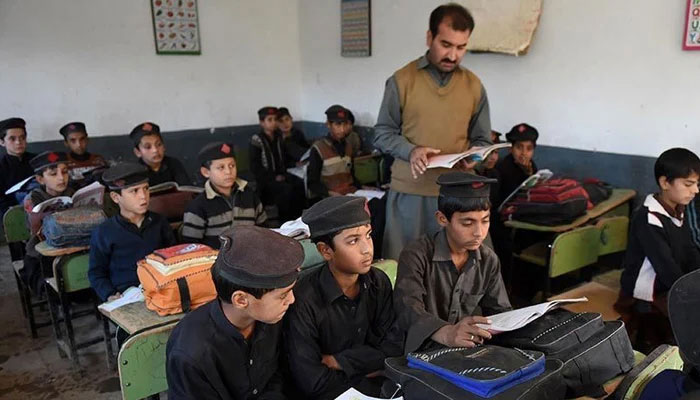Education emergency in Pakistan: Facing the stark realities
Prime Minister Shahbaz Sharif has declared an "Education Emergency" in Pakistan, acknowledging the systemic challenges that have plagued the education sector for years. His announcement has resonated nationwide, bringing attention to a critical issue often overlooked in policy discussions. One of the most pressing initiatives introduced is a nationwide campaign to enroll out-of-school children, a bold and necessary step to address a significant gap in the educational system. However, this declaration also prompts deep questions about the capacity of the current infrastructure to meet these ambitious objectives.
Education in Pakistan has been in a state of crisis for many years. The country's education expenditure is less than 2% of the GDP, significantly below the global average for developing nations. This chronic underfunding has severe implications across all levels of education, from primary schools to higher education institutions. An underfunded education sector struggles with numerous issues, including inadequate infrastructure, outdated curricula and teaching methods, and insufficient resources.
The alarming number of out-of-school children is a major concern. An estimated 22.8 million children aged 5 to 16, accounting for over 40% of the total school-age population, are not enrolled in school. The reasons behind this are varied: economic instability leading children into labour, cultural norms restricting girls' education, and geographical disparities that hinder access to schools for children in rural or conflict-affected areas.
The situation worsens when examining regional disparities. In provinces like Baluchistan, the literacy rate and the number of school-going children are significantly below the national average. This gap stems from a historical lack of investment, social inequalities, and the isolation of certain communities.
The higher education sector is facing a funding crisis that poses a risk of destabilising universities and compromising educational standards. Issues such as the non-appointment of regular vice chancellors, excessive external interference, and over-regulation have also impacted the performance of universities. Despite occasional commitments from successive governments, the funding allocated to education has not met the sector's requirements.
Spending less than 2% of GDP on education has led to insufficient investment in new infrastructure, curriculum development, and educational technology. Ironically, well-intentioned education policies suffer from inconsistent implementation due to corruption, inefficiency, and a lack of coordination between federal and provincial governments. With a population of over 220 million, the demand for schooling is outpacing the government's capacity to construct new schools and adequately train teachers. This crisis is exacerbated by a poorly compensated and under-trained teacher workforce.
The announcement of an Education Emergency raises hopes that education will finally receive the attention it demands.
The government must significantly increase its investment in education to at least 4% of GDP aligning Pakistan with its regional peers. This funding should prioritise building new schools in under-served areas, updating curricula to meet modern standards, and investing in educational technology.
Encouraging collaboration between the public and private sectors could help address gaps in educational infrastructure and management. NGOs and the private sector can supplement government efforts.
Improving the quality of education hinges on enhancing pre- and in-service teacher training programs and offering competitive salaries.
For universities to be competitive, serve as research hubs, and produce skilled graduates, they need adequate funding. This involves not only addressing immediate financial gaps but also developing long-term strategies for revenue generation, such as alumni funding, research grants, and international partnerships. Last month, during a National Assembly session, it was revealed that the recurring funding for public sector universities has remained stagnant at Rs. 65 billion since 2018, despite the increase in financial requirements of the universities from 21% in 2018-19 to 45% in 2023-24. Pakistan's top-ranked federal university, Quaid-i-Azam University, faces an annual deficit of more than 500 million rupees. The University of Baluchistan has been unable to pay salaries to its faculty and staff for the last four months, and most public sector universities are facing similar situations.
Another significant problem in the higher education sector is adhocism. According to the recent alarming report by the Higher Education Commission presented to the Supreme Court of Pakistan, 43% of public sector universities (66 out of 154) are operating without permanent vice chancellors or rectors.
Prime Minister Shahbaz Sharif's statement is a promising start, but the hard work of translating these goals into reality remains a significant challenge. An education emergency can galvanise the government and society to take the necessary steps to ensure every child has the opportunity to learn and grow. The country must urgently increase its investment in education, streamline policy implementation, encourage public-private partnerships, and build a future where knowledge is a universal right and education is a top priority.
-
 Philippines Blocks Elon Musk’s Grok AI
Philippines Blocks Elon Musk’s Grok AI -
 Jennifer Lawrence Blames Internet For Losing Sharon Tate Role
Jennifer Lawrence Blames Internet For Losing Sharon Tate Role -
 DeepMind, Google CEOs Sync Daily To Accelerate AI Race Against OpenAI
DeepMind, Google CEOs Sync Daily To Accelerate AI Race Against OpenAI -
 Japan Launches Probe Into 'Grok AI' Following Global Scrutiny Over 'inappropriate' Content
Japan Launches Probe Into 'Grok AI' Following Global Scrutiny Over 'inappropriate' Content -
 Prince Harry All Set To Return To Britain Next Week?
Prince Harry All Set To Return To Britain Next Week? -
 Is Princess Charlotte Becoming Most Confident Young Royal?
Is Princess Charlotte Becoming Most Confident Young Royal? -
 ‘Stranger Things’ Star David Harbour Speaks Up About ‘psychotherapy’
‘Stranger Things’ Star David Harbour Speaks Up About ‘psychotherapy’ -
 Jennifer Love Hewitt Talks About Scary 9-1-1 Episode
Jennifer Love Hewitt Talks About Scary 9-1-1 Episode -
 Kate Middleton Ditches Palace Life For Where She 'truly Relaxes'
Kate Middleton Ditches Palace Life For Where She 'truly Relaxes' -
 Pixel Watch May Soon Warn You If You Leave It Behind
Pixel Watch May Soon Warn You If You Leave It Behind -
 Serious Liver Scarring Shows Potential To Be Reversed With Latest Drug
Serious Liver Scarring Shows Potential To Be Reversed With Latest Drug -
 Elon Musk Backs Donald Trump To Invoke Insurrection Act Amid Minnesota Protests
Elon Musk Backs Donald Trump To Invoke Insurrection Act Amid Minnesota Protests -
 Scientists Unravel Mystery Of James Webb’s ‘little Red Dots’ In Deep Space
Scientists Unravel Mystery Of James Webb’s ‘little Red Dots’ In Deep Space -
 Nano Banana Explained: How Google’s AI Got Its Name
Nano Banana Explained: How Google’s AI Got Its Name -
 Fire Causes Power Outage On Tokyo Train Lines, Thousands Stranded As ‘operations Halted’
Fire Causes Power Outage On Tokyo Train Lines, Thousands Stranded As ‘operations Halted’ -
 YouTube, BBC To Ink Landmark Deal To Launch Exclusive Bespoke Shows
YouTube, BBC To Ink Landmark Deal To Launch Exclusive Bespoke Shows




